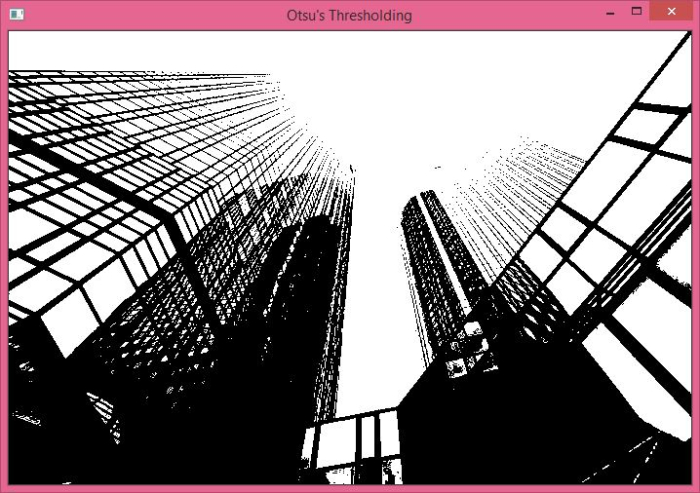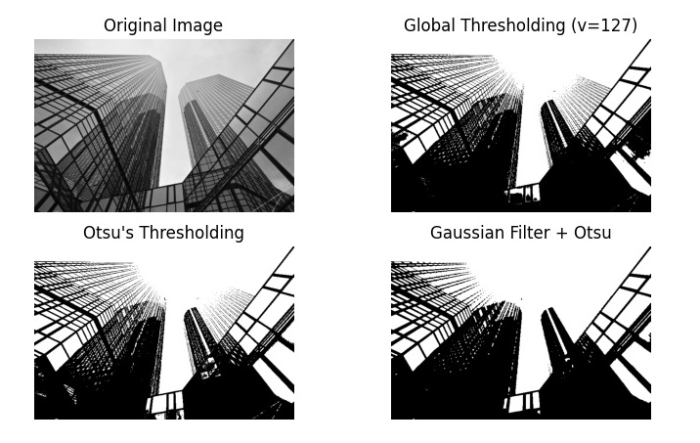
 Data Structure
Data Structure Networking
Networking RDBMS
RDBMS Operating System
Operating System Java
Java MS Excel
MS Excel iOS
iOS HTML
HTML CSS
CSS Android
Android Python
Python C Programming
C Programming C++
C++ C#
C# MongoDB
MongoDB MySQL
MySQL Javascript
Javascript PHP
PHP
- Selected Reading
- UPSC IAS Exams Notes
- Developer's Best Practices
- Questions and Answers
- Effective Resume Writing
- HR Interview Questions
- Computer Glossary
- Who is Who
How to perform Otsu's thresholding on an image using Python OpenCV?
Otsu's thresholding is a kind of thresholding technique. There are other types of thresholding techniques such as simple thresholding and adaptive thresholding.
The simple thresholding technique uses a global threshold value while the adaptive thresholding technique uses different threshold values for different regions.
Otsu's thresholding technique uses a global threshold value but it is not chosen. It is determined automatically. It works accurately for bimodal images. The bimodal images are those images whose histogram has two peaks. The threshold value is the approximate value of the middle of these two peaks. If the image is not bimodal this thresholding is not accurate.
To apply Otsu's thresholding, we apply simple thresholding cv2.threshold() with extra flag cv2.THRESH_OTSU. See the syntax given below.
Syntax
cv2.threshold(img, thresh_val, max_valu, thresh_techniques)
Parameters
img ? Input gray scale image. It's a numpy.ndarray.
thresh_val ? Threshold value. If the pixel value is higher than the threshold value, it is assigned one value else another value.
max_valu ? Maximum value to be assigned to a pixel
thresh_techniques ? Thresholding technique used. We can apply any simple thresholding + Otsu's thresholding, i.e., cv2.THRESH_BINARY + cv2.THRESH_OTSU
It returns the globally adapted threshold value and the threshold.
Let's understand Otsu's thresholding with the help of some Python examples
Input Image
We will use this image as the input file in the following examples.

Example 1
In this program, we apply Otsu's thresholding on the input image.
# import required libraries import cv2 # read the input image as a gray image img = cv2.imread('architecture2.jpg',0) # Apply Otsu's thresholding _,th = cv2.threshold(img,0,255,cv2.THRESH_BINARY+cv2.THRESH_OTSU) # display the output image cv2.imshow("Otsu's Thresholding", th) cv2.waitKey(0) cv2.destroyAllWindows()
Output
When you run the above program, it will produce the following output ?

The above output shows the image after applying Otsu's Thresholding.
Example 2
In this program, we apply Otsu's thresholding on the input image. We also apply global thresholding and gaussian filter + Otsu's thresholding.
import cv2 from matplotlib import pyplot as plt img = cv2.imread('architecture2.jpg',0) # Apply global (simple) thresholding on image ret1,th1 = cv2.threshold(img,127,255,cv2.THRESH_BINARY) # Apply Otsu's thresholding on image ret2,th2 = cv2.threshold(img,0,255,cv2.THRESH_BINARY+cv2.THRESH_OTSU) # Apply Otsu's thresholding after Gaussian filtering blur = cv2.GaussianBlur(img,(5,5),0) ret3,th3 = cv2.threshold(blur,0,255,cv2.THRESH_BINARY+cv2.THRESH_OTSU) titles = ['Original Image','Global Thresholding (v=127)',"Otsu's Thresholding",'Gaussian Filter + Otsu'] images = [img,th1,th2,th3] for i in range(4): plt.subplot(2,2,i+1) plt.imshow(images[i], 'gray') plt.title(titles[i]) plt.axis("off") plt.show()
Output
When you run the above program, it will produce the following output ?

The above output shows the different images after applying global thresholding, Otsu's thresholding and Gaussian filters + Otsu's thresholding.

